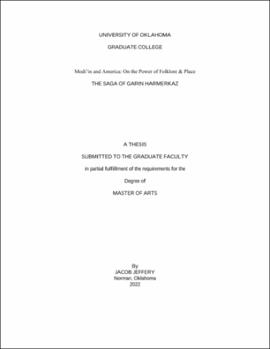| dc.contributor.advisor | Siedelman, Rhona | |
| dc.contributor.author | Jeffery, Jacob | |
| dc.date.accessioned | 2022-12-22T14:01:15Z | |
| dc.date.available | 2022-12-22T14:01:15Z | |
| dc.date.issued | 2022-12-16 | |
| dc.identifier.uri | https://hdl.handle.net/11244/336974 | |
| dc.description.abstract | Modiin is the site of both an ancient Jewish community and the modern nation’s ‘city of the future.’ This dichotomy is at the heart of a public battle between preservationists trying to raise awareness of the area’s rich Hannukah-related history and developers keen on making a profit. Less well-known is how this landscape has functioned as a mediating agent between American Jews and the State of Israel. The demilitarization of the Green Line made the civilian settlement of the long-time pilgrimage site feasible. For American olim looking to connect with their spiritual heritage, the notion of restoring Modiin offered an attractive alternative to Jerusalem’s volatility. Designated by the Jewish Agency as a destination for emigration from the American Reform community, this contemporary association builds on the region’s heritage as a bridge between the spiritual and physical realms of Israel.
In this paper, I ask how American Aliyah to Modi’in the years 1967-77 was organized, what the experience of immigration and settlement in the city was like for these emmigrants and the impact that they had on this city’s development. My work points to the significance of modern Modiin’s central planning and high quality of life. Additionally, my work contributes to the important historiographical literature on modern Israeli urbanization of such scholars as Maoz Azaryahu, Ilan Troen, Yehuda Grados and Esther Meir-Glitzenstein. I focus on a theme that appears repeatedly in archival documents: that these Americans were returning to the home of the Maccabees. I analyze the use of this theme to argue that it was central to lifting these immigrants’ expectations of the grandeur of their Aliya to Modi’in. This, in turn, significantly contributed to their disastrous experience of settlement and integration. | en_US |
| dc.language | en_US | en_US |
| dc.rights | Attribution-NonCommercial-NoDerivatives 4.0 International | * |
| dc.rights.uri | https://creativecommons.org/licenses/by-nc-nd/4.0/ | * |
| dc.subject | Maccabees | en_US |
| dc.subject | Modiin | en_US |
| dc.subject | American Aliyah | en_US |
| dc.subject | Landscape and Memory | en_US |
| dc.title | Modi’in and America: On the Power of Folklore & Place. The Saga of Garin Harmerkaz | en_US |
| dc.contributor.committeeMember | Levenson, Alan | |
| dc.contributor.committeeMember | Shepkaru, Shmuel | |
| dc.date.manuscript | 2022-12 | |
| dc.thesis.degree | Master of Arts | en_US |
| ou.group | Dodge Family College of Arts and Sciences::Department of History | en_US |
| shareok.orcid | 0000-0001-8554-4709 | en_US |
| shareok.nativefileaccess | restricted | en_US |

